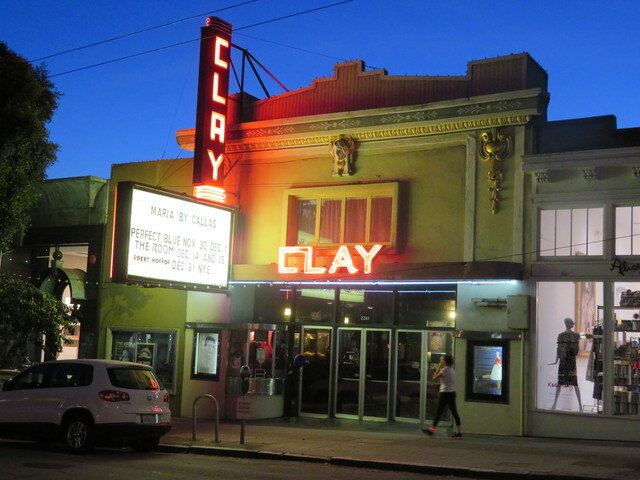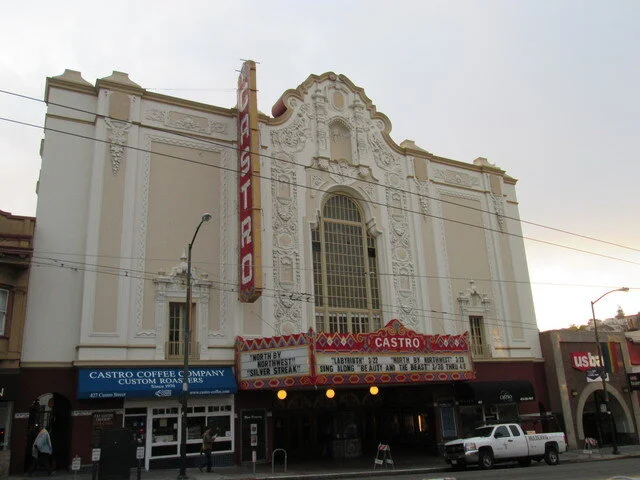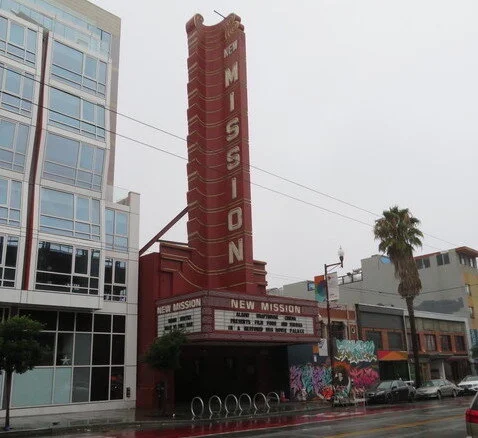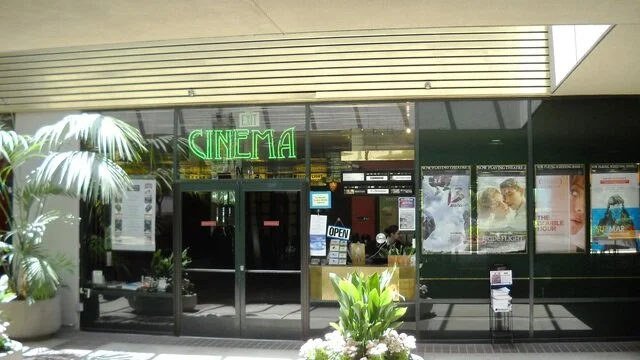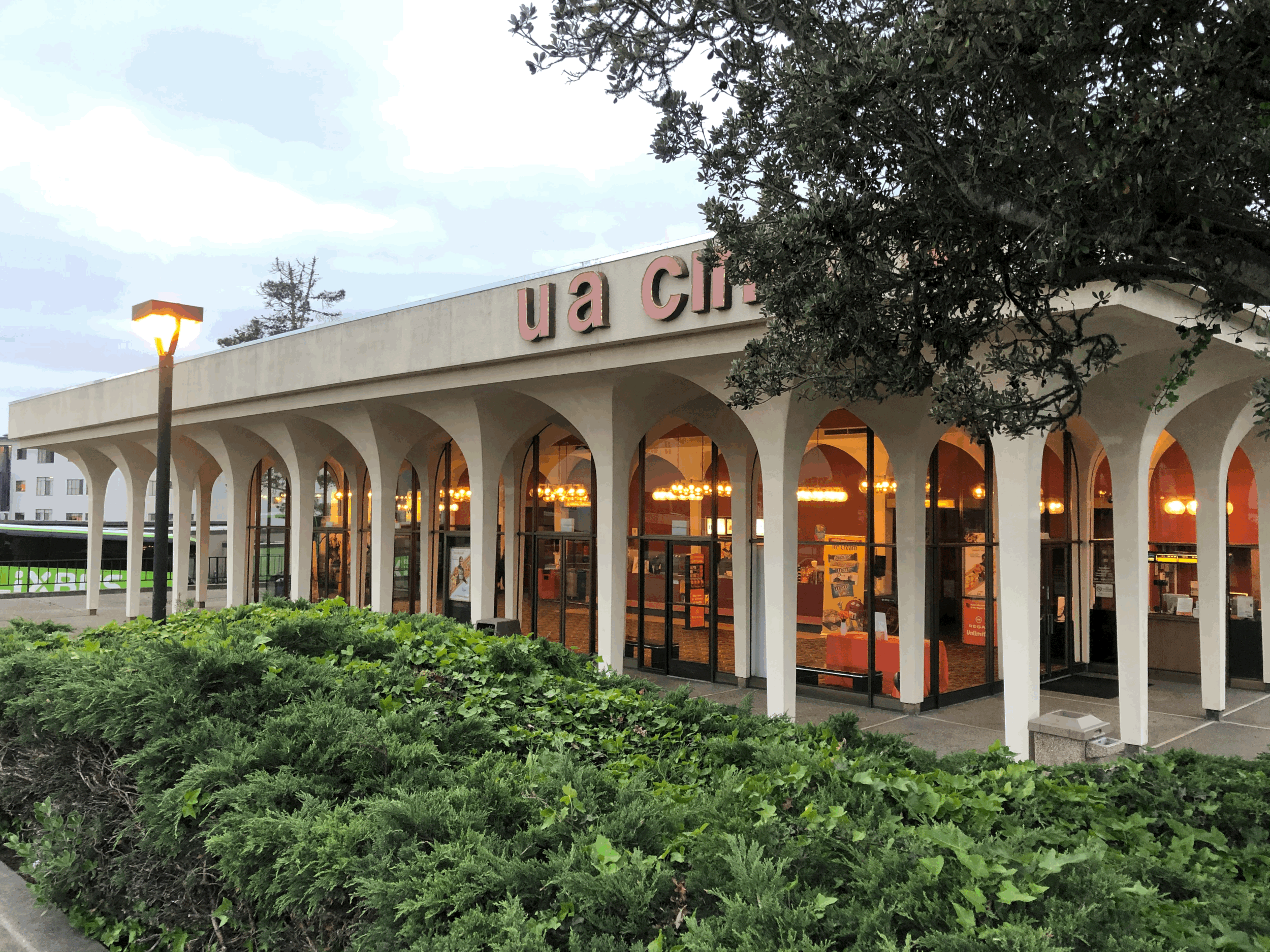Spring 2022 theater updates
Preservation Priorities
Clay - Pacific Heights
The Clay opened as the Regent in 1913. Under Herbert Rosener, it became the Clay International in 1935 and would remain one of the most important destinations for foreign and independent films in the city for 85 years. Vincent Raney, later architect of the space-age Century domes, remodeled the theater in 1946. It also became a top destination for midnight movies and was one of director John Waters’ favorite theaters. Its elegant, simply decorated auditorium recalls a jewel box.
The Clay’s corporate operator withdrew suddenly and the theater closed January 26, 2020. SFNTF’s offer to purchase the building at the owner’s previously stated terms was not accepted. Recently, he has sought to alter the building in order to market it for other commercial purposes. These plans would tear away an important part of the Fillmore corridor, to the detriment of neighboring residents and merchants. The Historic Preservation Committee voted unanimously in January 2022 to recommend a landmark designation for the Clay, and SFNTF continues to explore options to restore the Clay as an operating theater.
Empire - West Portal
The Portal opened in 1925 to serve the village that had come into its own in the seven years since the Twin Peaks Tunnel first pointed streetcars toward the city’s booming outside lands. It was renamed the Empire in 1936, when Anthony Heinsbergen, one of the foremost interior designers for movie theaters, redecorated it. Sadly, his design was covered or removed during a 1970 renovation. Ray Syufy, founder of Century Theatres, purchased the Empire in 1974 and divided it into three screens.
The Empire’s corporate operator announced in February 2021 that it would not reopen the theater, which had been closed since the pandemic started. Hundreds took to social media to share memories of what many consider one of the best-kept secrets of the neighborhood. SFNTF shares the perspective of many civic leaders who recognize the symbiotic relationship between the theater and surrounding businesses. We were pleased to learn that the Empire was recently purchased by relatives of its original owners, who plan to renovate the theater, and welcome the opportunity to work with them and community partners to bring movies back to this local treasure.
Proud Survivors
4-STAR - The Richmond
Reopening TBA
The 4-Star has served neighbors since 1913. Operated by Lee Neighborhood Theatres since 1992, it often highlights Hong Kong movies not seen elsewhere in the city. SFNTF fought to save the theater from demolition in the mid-2000s, including lobbying successfully for a legislative moratorium on theater alterations. The theater is currently being renovated by CinemaSF, which will reopen the theater later in the year with an exciting repertory format.
BALBOA - The Richmond
Reopened May 14th!
Designed by the renowned Reid Brothers, the Balboa opened in 1926, part of the Levin family’s circuit. The theater thrived as the neighborhood grew and was divided into two screens in 1978. The Levins handed the theater down to a successor in 2001, and SFNTF acquired the lease from him in 2011. After we initiated a series of improvements, operations were taken over by CinemaSF. Programming spans from current Hollywood blockbusters to exciting collaborations with local musicians, and its craft beer selection might be the best of any theater around.
CASTRO - The Castro
Reopening TBA
The Castro will celebrate its 100th birthday in 2022. A delightful melange of international styles and an early work of Timothy Pfleuger, it was made a city landmark in 1977. Today it shows a thoughtful mix of classic and current films, including its famous singalongs, and is sought-after for film festivals and occasional live events. Among the last theaters anywhere to employ a house organist, the Castro will become home in the next few years to the world’s largest digital/pipe hybrid instrument.
MARINA - The Marina
Reopened October 1st!
The elegant Moorish facade of the Marina has stood proudly among Chestnut Street businesses since 1928. Vincent Raney supervised a 1952 renovation, and in 1965 it was renamed Cinema 21, presenting longer engagements of movies which might previously have been found exclusively downtown. It closed in 2001 and was earmarked for a chain pharmacy. SFNTF brokered a compromise by which the store was built on the ground floor with two screens operated by Lee Neighborhood Theatres upstairs, helping maintain a vital neighborhood feature.
NEW MISSION - The Mission
Reopened September 10th!
1916 saw a small nickelodeon made into the lobby of an ornate new theater. Timothy Pfleuger carried out an Art Deco renovation in 1932 and the theater remained largely unchanged until closing in 1993. It operated as a furniture store and was occasionally vandalized. SFNTF fought for this diamond in the rough as it changed hands throughout the 2000s between parties uncommitted to preserving it in its entirety or at all, earned landmark status, and finally was stunningly restored by the Alamo Drafthouse Cinema chain. Now a five-screen outlet teeming with life, the New Mission is one of the great success stories of theater preservation in the country.
OPERA PLAZA - Civic Center
Reopened November 19h!
This four-screen art house opened in 1984 and has hosted many films’ exclusive engagements in the city. Neighbors were alarmed when the owner submitted plans to convert the theater to office space. Instead, SFNTF leased it in 2020 after facilitating the donation by several local business leaders of a substantial sum. The renovated theater has received local acclaim since its reopening. Civic leaders believe the Opera Plaza will help bring the public back to this stretch of Van Ness Avenue, acting as an adjunct to the surrounding performing arts district.
PRESIDIO - The Marina
Reopened May 27th!
This understated Streamline Moderne treasure first screened films in 1937, offering neighbors a chance to see recent films near home. After several format changes, it fell on hard times. SFNTF lobbied against a deal to replace the theater with a gym, which the Planning Board refused. Instead, Lee Neighborhood Theatres took over in 2003. They show a mix of mainstream and indie films, now on four screens, and remain an important contributor to the thriving Chestnut Street commercial corridor.
ROXIE - The Mission
Reopened May 21st!
The Roxie has been known by several names and shown many different types of films over more than a century. It recentered itself around foreign and independent films beginning in 1976, opened a second screen in an adjacent storefront in 2003, and gained nonprofit status in 2009. The theater raised its profile further this year when Sundance Film Festival made it their Bay Area home for satellite screenings: a dozen films sold out a temporary drive-in. It has also renovated its lobby, including the installation of an accessible restroom, and remains a beloved community resource.
STONESTOWN - Stonestown
Reopening TBA
Among the last single-screen theaters built in the city, the United Artists Cinema opened across from Stonestown Shopping Center in 1970 and divided into two screens in 1973. It serves mall patrons and neighbors, and this year became the only theater on the West Side south of the park. Designed by George Raad, it is a rare example of the pavilion-style mid-century modern architecture that was briefly very popular. UA’s successor plans to open a multiplex in the mall proper to replace this theater soon.
VOGUE - Presidio Heights
Reopened May 29th!
This theater has proudly served its neighbors since 1912 with eclectic programming. The eventual corporate owner of the Vogue discreetly offered it for sale for several years, announcing plans in 2004 to sell it to a developer for gutting or demolition. SFNTF fought hard to secure funding to prevent the destruction of this neighborhood landmark, purchasing it in 2007. After significant upgrades, it is operated in partnership with Cinema SF, showing a mix of new and classic films, and is a venue for special series including the Mostly British Film Festival.
Future Opportunities
Avenue - The Portola
The Avenue was designed by the Reid Brothers for a 1927 opening. To differentiate itself among dozens of competitors, operators shifted focus to silent films with organ accompaniment in 1966. This continued successfully until 1984, when the landlord declined to renew the theater’s lease, indicating an intent to redevelop. Instead, the space was used as a church until becoming vacant in 2015. Its interior remains in astonishingly good structural and aesthetic condition.
The facade and neon sign were restored, largely with city funding, in 2017. Within months of the relighting ceremony, long-vacant commercial space in the building was filled by a local entrepreneur’s successful ice cream startup. How much more could the Avenue bring to this community as an arts venue? Neighborhood organizations share a desire for a reactivated theater, and SFNTF remains involved in the search for the right operator to revive this beacon at the heart of the Portola
El Rey - Ocean Avenue
Opened in 1931, this Streamline Moderne theater, with its distinctive tower, is the work of the acclaimed Timothy Pfleuger. It became a successful neighborhood house, and the Gap opened its first store in one of its commercial spaces in 1969. In 1977, the theater was closed and the building sold to a church, which lost it to investors after a 2015 foreclosure. SFNTF helped facilitate its recognition as a city landmark in 2017, which had been impossible under the church’s purview.
The new owners proposed to restore the theater inside and out according to Pfleuger’s construction documents, as well as to renovate the building’s commercial spaces and add 42 condos above. We are pleased to report that after a stall, the proposed project is back on track. Reactivating the highly visible El Rey is essential as Ocean Avenue comes back to life, and SFNTF joins neighborhood organizations in working toward a brighter future here.
Other Updates
Alexandria - The Richmond
The Alexandria, a neighborhood fixture since 1923, has languished since it was closed suddenly in 2004. 43 condos were built on its parking lot, but plans for and ownership of the theater have changed several times. The Planning Commission recently approved adaptive re-use as a members-only aquatic center, without the small theater for which SFNTF advocated in order to keep this grand space publicly accessible.
Bridge - Laurel Heights
A relatively late entrant to the city movie scene, the Bridge opened in 1939 as an outlet for movies still in demand after multiple runs elsewhere in the city. Embraced by the neighborhood, it eventually showed art films in their exclusive San Francisco runs, continuing in this vein until 2012. The theater was closed and sold to the San Francisco Baseball Academy, which preserved its exterior while installing batting cages within.
Crown - The Mission
The Wigwam opened as a vaudeville house just months after the Great Earthquake. Its first building was replaced in 1913 by a new theater built for vaudeville and films. Later known as the Rialto, the Crown, and Cine Latino, the theater closed in 1987. Its owner announced plans in 2012 for a gym and restaurant, and destroyed the theater’s facade while gutting its interior. The theater has remained bare framework for nearly a decade.
Harding - Alamo Square
The renovation of the Harding as the Emporium, a popular arcade bar opened in 2017, shows the importance of persistence. Investors sought to capitalize on neighbors’ impatience with vacancy by first proposing to demolish this striking 1926 building, then to gut it, but were rebuffed on appeal thanks to the advocacy of groups including SFNTF. There was always a path forward for this landmark, with the right partners.
Presidio - The Presidio
Generous private philanthropy allowed this theater, built in 1938 for army personnel and their families to enjoy movies on base, to reopen as a venue primarily for live performance. After 25 years closed, this new space is an important step in the mixed-use revitalization of the Presidio, and the project demonstrates the potential flexibility of historic cinema spaces to serve new purposes when appropriate.
Tower - The Mission
Opened in 1912, the Tower has been closed to the general public for a quarter century. Ambitious plans were submitted in 2017 to renovate the theater as a film school and showcase, but there have been no recent public updates. Restoration of the striking Streamline Moderne facade would benefit neighboring businesses, and WPA murals within are an important but little-known part of the Mission’s artistic heritage.
